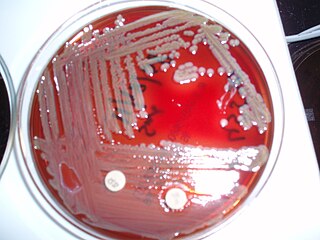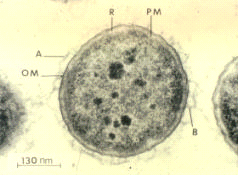Related Research Articles

A biofilm is a syntrophic community of microorganisms in which cells stick to each other and often also to a surface. These adherent cells become embedded within a slimy extracellular matrix that is composed of extracellular polymeric substances (EPSs). The cells within the biofilm produce the EPS components, which are typically a polymeric combination of extracellular polysaccharides, proteins, lipids and DNA. Because they have a three-dimensional structure and represent a community lifestyle for microorganisms, they have been metaphorically described as "cities for microbes".

Vibrio is a genus of Gram-negative bacteria, possessing a curved-rod (comma) shape, several species of which can cause foodborne infection, usually associated with eating undercooked seafood. Being highly salt tolerant and unable to survive in fresh water, Vibrio spp. are commonly found in various salt water environments. Vibrio spp. are facultative anaerobes that test positive for oxidase and do not form spores. All members of the genus are motile. They are able to have polar or lateral flagellum with or without sheaths. Vibrio species typically possess two chromosomes, which is unusual for bacteria. Each chromosome has a distinct and independent origin of replication, and are conserved together over time in the genus. Recent phylogenies have been constructed based on a suite of genes.
Plesiomonas shigelloides is a species of bacteria and the only member of its genus. It is a Gram-negative, rod-shaped bacterium which has been isolated from freshwater, freshwater fish, shellfish, cattle, goats, swine, cats, dogs, monkeys, vultures, snakes, toads and humans. It is considered a fecal coliform. P. shigelloides is a global distributed species, found globally outside of the polar ice caps.

Burkholderia is a genus of Pseudomonadota whose pathogenic members include the Burkholderia cepacia complex, which attacks humans and Burkholderia mallei, responsible for glanders, a disease that occurs mostly in horses and related animals; Burkholderia pseudomallei, causative agent of melioidosis; and Burkholderia cepacia, an important pathogen of pulmonary infections in people with cystic fibrosis (CF). Burkholderia species is also found in marine environments. S.I. Paul et al. (2021) isolated and characterized Burkholderia cepacia from marine sponges of the Saint Martin's Island of the Bay of Bengal, Bangladesh.

Aeromonas hydrophila is a heterotrophic, Gram-negative, rod-shaped bacterium mainly found in areas with a warm climate. This bacterium can be found in fresh or brackish water. It can survive in aerobic and anaerobic environments, and can digest materials such as gelatin and hemoglobin. A. hydrophila was isolated from humans and animals in the 1950s. It is the best known of the species of Aeromonas. It is resistant to most common antibiotics and cold temperatures and is oxidase- and indole-positive. Aeromonas hydrophila also has a symbiotic relationship as gut flora inside of certain leeches, such as Hirudo medicinalis.
Photobacterium is a genus of gram-negative, oxidase positive and catalase positive bacteria in the family Vibrionaceae. Members of the genus are bioluminescent, that is they have the ability to emit light.

The class Flavobacteriia is composed of a single class of environmental bacteria. It contains the family Flavobacteriaceae, which is the largest family in the phylum Bacteroidota. This class is widely distributed in soil, fresh, and seawater habitats. The name is often spelt Flavobacteria, but was officially named Flavobacteriia in 2012.
Vibrio alginolyticus is a Gram-negative marine bacterium. It is medically important since it causes otitis and wound infection. It is also present in the bodies of animals such as pufferfish, where it is responsible for the production of the potent neurotoxin, tetrodotoxin.

Aeromonas salmonicida is a pathogenic bacterium that severely impacts salmonid populations and other species. It was first discovered in a Bavarian brown trout hatchery by Emmerich and Weibel in 1894. Aeromonas salmonicida's ability to infect a variety of hosts, multiply, and adapt, make it a prime virulent bacterium. A. salmonicida is an etiological agent for furunculosis, a disease that causes sepsis, haemorrhages, muscle lesions, inflammation of the lower intestine, spleen enlargement, and death in freshwater fish populations. It is found worldwide with the exception of South America. The major route of contamination is poor water quality; however, it can also be associated stress factors such as overcrowding, high temperatures, and trauma. Spawning and smolting fish are prime victims of furunculosis due to their immunocompromised state of being.

Streptococcus iniae is a species of Gram-positive, sphere-shaped bacterium belonging to the genus Streptococcus. Since its isolation from an Amazon freshwater dolphin in the 1970s, S. iniae has emerged as a leading fish pathogen in aquaculture operations worldwide, resulting in over US$100M in annual losses. Since its discovery, S. iniae infections have been reported in at least 27 species of cultured or wild fish from around the world. Freshwater and saltwater fish including tilapia, red drum, hybrid striped bass, and rainbow trout are among those susceptible to infection by S. iniae. Infections in fish manifest as meningoencephalitis, skin lesions, and septicemia.

Vibrio anguillarum is a species of prokaryote that belongs to the family Vibrionaceae, genus Vibrio. V. anguillarum is typically 0.5 - 1 µm in diameter and 1 - 3 µm in length. It is a gram-negative, comma-shaped rod bacterium that is commonly found in seawater and brackish waters. It is polarly flagellated, non-spore-forming, halophilic, and facultatively anaerobic. V. anguillarum has the ability to form biofilms. V. anguillarum is pathogenic to various fish species, crustaceans, and mollusks.
Tenacibaculum amylolyticum is a bacterium. It was first isolated from sponge and green algae which were collected on the coast of Japan and Palau. Its type strain is MBIC 4355T.
Tenacibaculum lutimaris is a bacterium. It was first isolated from the Yellow Sea, Korea. It is Gram-negative, rod-shaped and its type strain is TF-26T.
Tenacibaculum adriaticum is a bacterium. It is rod-shaped, translucent yellow-pigmented, Gram-negative and its type strain is B390T. This species is able to hydrolyse aesculin.
Tenacibaculum skagerrakense is a bacterium. It is named after Skagerrak, Denmark, where it was first isolated. Its type strain is D30T.
Yersinia ruckeri is a species of Gram-negative bacteria, known for causing enteric redmouth disease in some species of fish. Strain 2396-61 is its type strain.
Tenacibaculum is a Gram-negative and motile bacterial genus from the family of Flavobacteriaceae.
Tenacibaculum dicentrarchi is a Gram-negative and rod-shaped bacterium from the genus of Tenacibaculum which has been isolated from the European sea bass from Spain.
Tenacibaculum discolor is a Gram-negative and rod-shaped bacterium from the genus of Tenacibaculum which has been isolated from the kidney of a sole Solea senegalensis from Galicia in Spain.
Tenacibaculum maritimum is a bacterium from the genus of Tenacibaculum. Tenacibaculum maritimum can cause skin infections in marine fish. The disease caused by Tenacibaculum maritimum is called Tenacibaculosis.
References
- ↑ Pineiro-Vidal, M.; Carballas, C. G.; Gomez-Barreiro, O.; Riaza, A.; Santos, Y. (2008). "Tenacibaculum soleae sp. nov., isolated from diseased sole (Solea senegalensis Kaup)". International Journal of Systematic and Evolutionary Microbiology. 58 (4): 881–885. doi: 10.1099/ijs.0.65539-0 . ISSN 1466-5026. PMID 18398187.
- ↑ Austin, Brian, and D. Dawn A. Austin. Bacterial fish pathogens: diseases of farmed and wild fish. Springer, 2007.
- ↑ López, J R; Piñeiro-Vidal, M; García-Lamas, N; de la Herran, R; Navas, J I; Hachero-Cruzado, I; Santos, Y (2010). "First isolation of Tenacibaculum soleae from diseased cultured wedge sole, Dicologoglossa cuneata (Moreau), and brill, Scophthalmus rhombus (L.)". Journal of Fish Diseases. 33 (3): 273–278. Bibcode:2010JFDis..33..273L. doi:10.1111/j.1365-2761.2009.01105.x. ISSN 0140-7775. PMID 19878529.